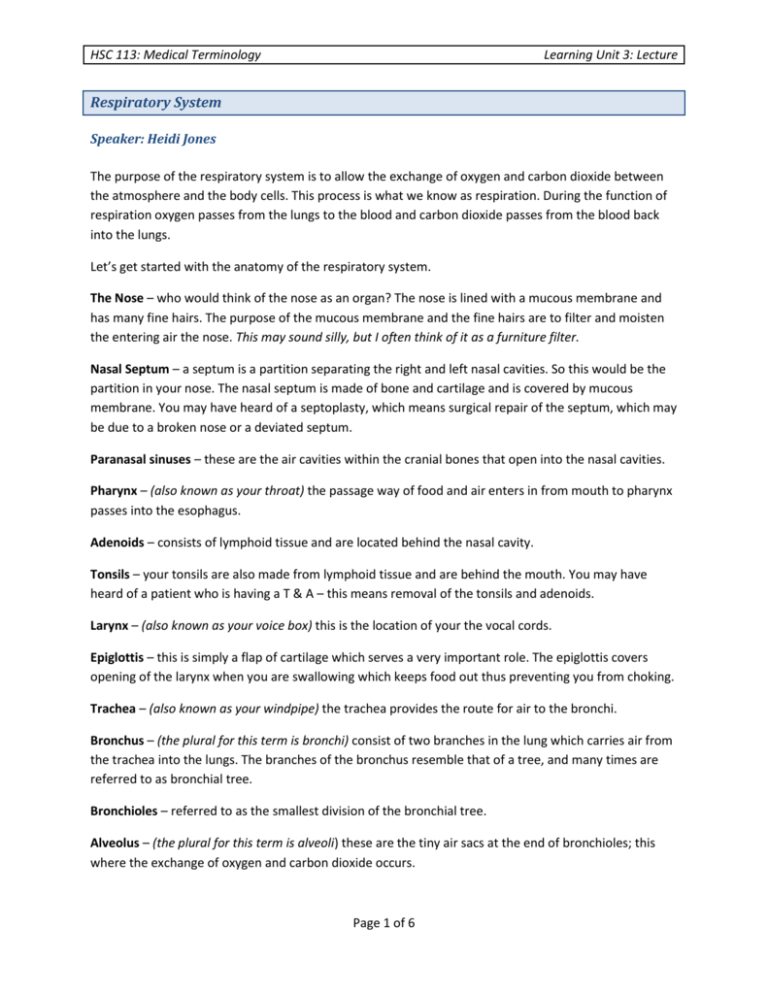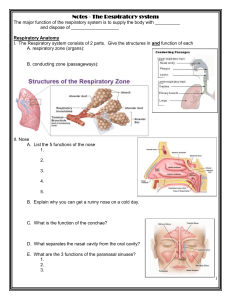Respiratory System
advertisement

HSC 113: Medical Terminology Learning Unit 3: Lecture Respiratory System Speaker: Heidi Jones The purpose of the respiratory system is to allow the exchange of oxygen and carbon dioxide between the atmosphere and the body cells. This process is what we know as respiration. During the function of respiration oxygen passes from the lungs to the blood and carbon dioxide passes from the blood back into the lungs. Let’s get started with the anatomy of the respiratory system. The Nose – who would think of the nose as an organ? The nose is lined with a mucous membrane and has many fine hairs. The purpose of the mucous membrane and the fine hairs are to filter and moisten the entering air the nose. This may sound silly, but I often think of it as a furniture filter. Nasal Septum – a septum is a partition separating the right and left nasal cavities. So this would be the partition in your nose. The nasal septum is made of bone and cartilage and is covered by mucous membrane. You may have heard of a septoplasty, which means surgical repair of the septum, which may be due to a broken nose or a deviated septum. Paranasal sinuses – these are the air cavities within the cranial bones that open into the nasal cavities. Pharynx – (also known as your throat) the passage way of food and air enters in from mouth to pharynx passes into the esophagus. Adenoids – consists of lymphoid tissue and are located behind the nasal cavity. Tonsils – your tonsils are also made from lymphoid tissue and are behind the mouth. You may have heard of a patient who is having a T & A – this means removal of the tonsils and adenoids. Larynx – (also known as your voice box) this is the location of your the vocal cords. Epiglottis – this is simply a flap of cartilage which serves a very important role. The epiglottis covers opening of the larynx when you are swallowing which keeps food out thus preventing you from choking. Trachea – (also known as your windpipe) the trachea provides the route for air to the bronchi. Bronchus – (the plural for this term is bronchi) consist of two branches in the lung which carries air from the trachea into the lungs. The branches of the bronchus resemble that of a tree, and many times are referred to as bronchial tree. Bronchioles – referred to as the smallest division of the bronchial tree. Alveolus – (the plural for this term is alveoli) these are the tiny air sacs at the end of bronchioles; this where the exchange of oxygen and carbon dioxide occurs. Page 1 of 6 HSC 113: Medical Terminology Learning Unit 3: Lecture Lungs – referred to a two sponge-like organs that are located in the thoracic cavity. It is important to note that you right side of the lung has three lobes and your left side has two lobes. Pleura – is the serous membrane that provides a covering for each lung as well as the lining of the thoracic cavity. Diaphragm – is a muscular partition which separates the thoracic and abdominal cavities. Mediastinum – can be found in the thoracic cavity; it is the space between the lungs, which contains the heart, esophagus, trachea, as well as the great vessels. Here are the combining forms and definitions for the respiratory system: adenoid/o adenoids alveol/o alveolus bronch/i, bronch/o bronchus (it is important to note that both “o” and “i” are used with the word root) diaphragmat/o, phren/o diaphragm epiglott/o epiglottis laryng/o larynx lob/o lobe nas/o, rhin/o nose (I always think of the horn on a rhinocerous’ nose) pharyng/o pharynx pleur/o pleura pneum/o, pneumat/o, pneumon/o all mean lung, air pulmon/o lung sept/o septum sinus/o sinus thorac/o thorax (also known as chest) tonsill/o tonsils (notice tonsill/o has two “l”s) trachel/o trachea Page 2 of 6 HSC 113: Medical Terminology Learning Unit 3: Lecture The following are common combining forms used with the respiratory system: atel/o imperfect, incomplete capn/o carbon dioxide hem/o, hemat/o blood muc/o mucous orth/o straight ox/o, ox/i oxygen (again notice that both “o” and “i” are used as the combining vowel) phon/o sound, voice py/o pus somn/o sleep spir/o breathe, breathing Let’s continue on with prefixes: a-, an- without or absence of (This is important to note – “an” is used when the word root begins with a vowel) endo- within eu- normal or good (pronounced as “U”) pan- all, total poly- many, much (poly wants a cracker – poly wants many crackers) tachy- fast, rapid (a gauge on your car which notes how fast you are going) Suffixes: -algia pain -ar, -ary, -eal pertaining -cele hernia or protrusion -centesis surgical procedure to aspirate fluid -ectasis stretching out, dilatation, expansion Page 3 of 6 HSC 113: Medical Terminology Learning Unit 3: Lecture -emia blood condition -graphy process of recording, radiographic imaging -meter instrument used to measure -metry measurement -pexy surgical fixation, suspension -pnea breathing -rrhagia rapid flow of blood -scope instrument used for visual exam -scopic pertaining to visual examination -scopy visual examination -spasm sudden, involuntary muscle contraction -stenosis constriction or narrowing -stomy creation of an artificial opening -thorax chest -tomy cut into or incision Let’s define a few medical terms for the respiratory system – Rhinorrhagia: Start with orrhagia which means rapid flow of blood Move to rhino which means nose So you have rapid flow of blood from the nose, which is also known as epistaxis or a nosebleed Rhinomycosis: Start with osis which means abnormal condition Move to rhino is nose and then to my/o is fungus So you have an abnormal condition of a fungus in the nose – Yuck! Tonsillitis: (this is an easy one for you!) Start with itis which always means inflammation Move to tonsil means tonsils So you have inflammation on the tonsils Page 4 of 6 HSC 113: Medical Terminology Learning Unit 3: Lecture Laryngotracheobronchitis: Start with itis which means inflammation Move to laryngo which means larynx, move to tracho which means trachea and then to broncho which means bronchi So you have inflammation on the larynx, trachea, and bronchi – which in its acute form is known as the croup Let’s continue to break down a few surgical terms – Lobectomy: Start with ectomy which means excison Move to lob means lobe So you have removal of a lobe of the lung Tracheotomy: Start with tomy which means incision Move to trachea which means trachea So you have incision into the trachea Bronchoscopy: Start with scopy which means visual exam Move to broncho which means bronchi So you have visual exam of the bronchi Here are just a few of the common diseases of the respiratory system that are not built from word parts: Adult respiratory distress syndrome (ARDS) Asthma Chronic obstructive pulmonary disease (COPD) Croup Cystic fibrosis (CF) Influenza (also known as the flu) Obstructive sleep apnea (OSA) Pulmonary embolism (PE) Tuberculosis (TB) The following are a few diagnostic terms that are not built from word parts: Chest computed tomography (CT) scan Chest radiograph (CXR) Ventilation perfusion scanning (VPS) (also known as a lung scan) Page 5 of 6 HSC 113: Medical Terminology Learning Unit 3: Lecture Here are a few common laboratory tests for the respiratory system: Acid-fast bacilli (AFB) smear Arterial blood gases (ABGs) Pulmonary function tests (PFTs) Purified protein derivative skin test (PPD) (also call TB skin test) © Heidi Jones and Indian Hills Community College Page 6 of 6






